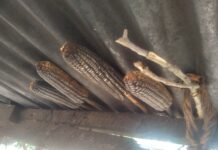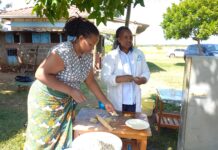By Pius Sawa
Audio story
Goat and sheep noises.
PS It is sunset in Kogilgil village, in Kotido District North Eastern Uganda. Maria Naduk is receiving home to goats and sheep. She gets milk from her goats. For Maria her goats are her major source of income because she can quickly sell some and pay school fees for her children or buy clothes and even pay for medical bills for her family. But like any other animal keeper in her community these small ruminants are at a high risk of dying from two types of diseases. Chrisostom Ayebazibwe a senior veterinary officer in Uganda’s government mentions the disease.
CA Peste des Petits Ruminants in short called PPR and Sheep and Goat Pox are the highly important goat and sheep diseases.
PS PPR can infect up to 90% of a flock or herd and it is fatal to up to 70% of infected animals while SGP has a mortality rate of about 50% and equally presents a significant loss for any livestock keeper.
CA If your goat or sheep is sick you will not get as much as you would get. If your goat gets sick it may fetch a tenth of what it is supposed to fetch as part of the market value.
PS The two decisions have been in Uganda for now several years and Chrisostom say its farmers can easily identify the sick animals.
CA Like for goat and sheep pox you cannot miss out the poor lesions on the animals. You get wounds, you get those nodules on their skin and certainly there is fever and in most cases also respiratory signs, discharges on the nose. For PPR also you get discharges on the nose and diarrhoea and also increased temperature but we see most goats getting heavy crusting in the mouth and also in the nose and eventually these ones impair the breathing and the goat can even die.
PS The vaccines for both PPR and SGP are available separately but are not widely used because control of PPR is currently under government agencies and the reaction is mostly when there is an outbreak, where in the case of SGP small holder farmers may not be aware that it is preventable and evidence exists.
The Global Alliance for Livestock Veterinary Medicines (GALVmed), a non-profit organisation has been working with the Moroccan based livestock vaccine manufacturer and other partners to make available a combined vaccine for PPR and SGP.
CA In 2015 we were blessed with a vaccine from MCI in Morocco. The Lyopox vaccine which is a combination vaccine that attacks both PPR and Poxand it initially started as a trial. We initially vaccinated 70,000 goats and sheep in Moroto and 30,000 in Sembabule.
PS GALVmed has also been working with partners to raise awareness about the two diseases and the combined vaccine. Abdallah Said Twahir is government’s Director of Market Development.
AT We do a lot of what we call sensitisation and awareness work so that they are aware that there is something that they can do, that they can take control of their livelihoods themselves. If they routinely vaccinated their animals then they would prevent the problem of epidemics coming up and clearing the entire livestock population that they hold. But that will take time and we have no choice but to do it and do it as effectively as we can. Being a combined vaccine it will be able to be sold through vets and agro vet shops in Africa where individual livestock keepers can go and buy and ask for the vaccination themselves rather than wait for outbreaks of disease. The combined vaccine is not yet registered in any one country at the moment. Our role has been to support the manufacturer to conduct field trials. Field trials were conducted in three countries. They were conducted in Tanzania, Uganda and Mali. One of the reasons for conducting the field trials was to collect data that will be used to support registration of the combined vaccine. And the second side of things was to also sensitise the poor livestock keepers that such a vaccine does exist and it works.
PS In Uganda commercial livestock keepers have expressed interest in paying for the vaccine as explains Chrisostom.
CA I can assure you the commercial farmers are always willing to have the vaccine whenever they need it. So if we are sensitised the farmers can meet the cost of vaccination. After all most of them want to guard against the disease getting introduced into the area.
PS This report was compiled by Pius Sawa for WRENmedia on behalf of GALVmed.














